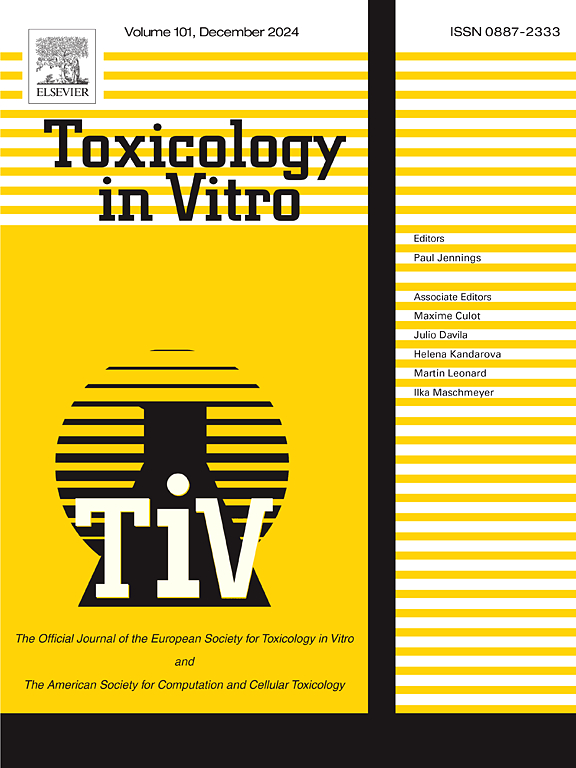Glutaraldehyde-crosslinked Naringenin-loaded Albumin Nanoparticles (GNANPs) induce antimicrobial properties and apoptosis in gastric cancer cells
IF 2.6
3区 医学
Q3 TOXICOLOGY
引用次数: 0
Abstract
An assessment of the anticancer activity of Glutaraldehyde-crosslinked Naringenin-loaded Albumin Nanoparticles (GNANPs) against gastric cancer cells was the purpose of this study. The increasing prevalence of gastric cancer and the limitations of conventional therapies necessitate novel approaches that combine targeted drug delivery with therapeutic efficacy. Several techniques were used to characterize the synthesized GNANPs, including UV–visible spectroscopy, X-ray diffractometer (XRD), scanning electron microscope (SEM), transmission electron microscope (TEM), Fourier transform infrared (FT-IR), dynamic light scattering (DLS), and photoluminescence (PL). They were evaluated for their antimicrobial properties, cytotoxicity, ROS accumulation, apoptotic activity, and oxidative stress markers against AGS cells. The characterization analyses indicated the existence of Glutaraldehyde-crosslinked Naringenin-loaded Albumin Nanoparticles with an oval-shaped morphology and an average particle size of 127.80 nm. The existence of several elements and functional groups in the GNANPs was also detected using EDX and FT-IR analyses, respectively. The synthesized GNANPs have shown exceptional antibacterial activities by effectively inhibiting the growth of several infections. The treatment of GNANPs efficiently inhibited the growth of AGS cells. Fluorescence staining studies showed increased apoptosis and oxidative stress markers in AGS cells treated with synthesized Glutaraldehyde-crosslinked Naringenin-loaded Albumin Nanoparticles, indicating their potential as a viable cancer treatment option.
戊二醛交联柚皮素负载白蛋白纳米颗粒(GNANPs)诱导胃癌细胞的抗菌特性和凋亡。
研究戊二醛交联柚皮素负载白蛋白纳米颗粒(GNANPs)对胃癌细胞的抗癌作用。胃癌发病率的增加和传统治疗方法的局限性需要结合靶向给药和治疗效果的新方法。采用紫外可见光谱、x射线衍射仪(XRD)、扫描电镜(SEM)、透射电镜(TEM)、傅里叶变换红外(FT-IR)、动态光散射(DLS)、光致发光(PL)等技术对合成的GNANPs进行了表征。评估它们的抗菌性能、细胞毒性、ROS积累、凋亡活性和对AGS细胞的氧化应激标志物。表征分析表明,戊二醛交联柚皮素负载白蛋白纳米颗粒呈椭圆形,平均粒径为127.80 nm。利用EDX和FT-IR分析,还分别检测了GNANPs中存在的几个元件和官能团。合成的GNANPs通过有效抑制几种感染的生长显示出优异的抗菌活性。GNANPs处理能有效抑制AGS细胞的生长。荧光染色研究显示,合成的戊二醛交联柚皮素白蛋白纳米颗粒处理AGS细胞后,细胞凋亡和氧化应激标志物增加,这表明它们有可能成为一种可行的癌症治疗选择。
本文章由计算机程序翻译,如有差异,请以英文原文为准。
求助全文
约1分钟内获得全文
求助全文
来源期刊

Toxicology in Vitro
医学-毒理学
CiteScore
6.50
自引率
3.10%
发文量
181
审稿时长
65 days
期刊介绍:
Toxicology in Vitro publishes original research papers and reviews on the application and use of in vitro systems for assessing or predicting the toxic effects of chemicals and elucidating their mechanisms of action. These in vitro techniques include utilizing cell or tissue cultures, isolated cells, tissue slices, subcellular fractions, transgenic cell cultures, and cells from transgenic organisms, as well as in silico modelling. The Journal will focus on investigations that involve the development and validation of new in vitro methods, e.g. for prediction of toxic effects based on traditional and in silico modelling; on the use of methods in high-throughput toxicology and pharmacology; elucidation of mechanisms of toxic action; the application of genomics, transcriptomics and proteomics in toxicology, as well as on comparative studies that characterise the relationship between in vitro and in vivo findings. The Journal strongly encourages the submission of manuscripts that focus on the development of in vitro methods, their practical applications and regulatory use (e.g. in the areas of food components cosmetics, pharmaceuticals, pesticides, and industrial chemicals). Toxicology in Vitro discourages papers that record reporting on toxicological effects from materials, such as plant extracts or herbal medicines, that have not been chemically characterized.
 求助内容:
求助内容: 应助结果提醒方式:
应助结果提醒方式:


